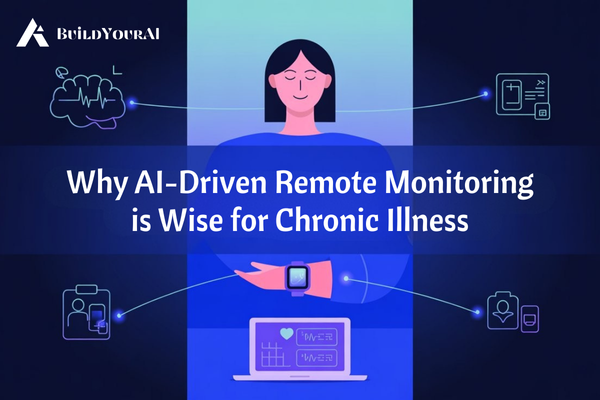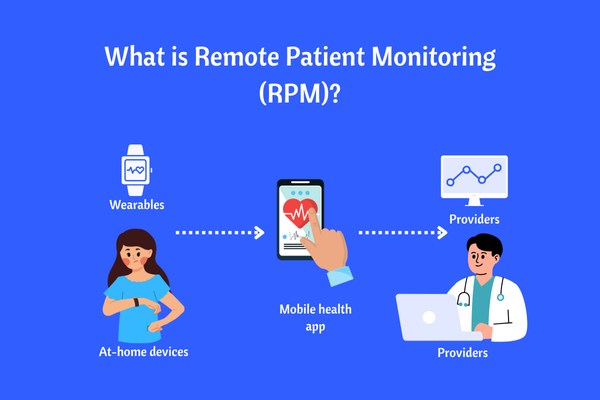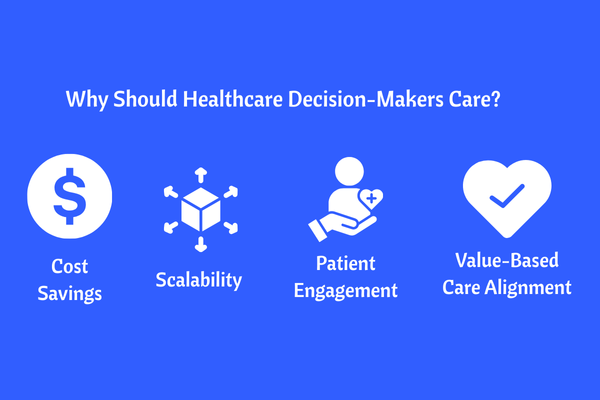
Blog
September 4, 2025 • 3 min read
You know, chronic diseases like diabetes, heart issues, breathing problems, and high blood pressure are becoming a pretty big deal worldwide. This means healthcare providers not only have to treat illnesses anymore; they also have to think about getting ahead of them. Traditional models of care that rely on in-person visits just don’t cut it anymore. That’s where AI-driven remote patient monitoring (RPM) steps in, ready to shake things up a bit! By blending artificial intelligence with digital health tools, healthcare leaders can seriously rethink how we deliver care, enhance patient experiences, and make the most of available resources.
Why Does Remote Patient Monitoring Matter Anyway?

Honestly, chronic diseases are responsible for a huge chunk of healthcare spending around the globe. The World Health Organization points out that about 74% of deaths each year are linked to these long-term conditions. Managing them requires constant lifestyle adjustments, regular monitoring, and timely interventions. These things are tough to achieve if you’re stuck in the old ways of hospital visits and occasional check-ups.
That’s where remote patient monitoring comes in! It uses cool tech like wearables, at-home medical devices, and mobile health apps to collect ongoing patient data outside the four walls of a hospital. But with all that new data, there’s a hefty challenge: making sense of it all quickly. That’s where AI-powered analytics saves the day.
How AI Fits into Remote Patient Monitoring

AI takes the raw data gathered from patients and turns it into practical, easy-to-understand insights. And for healthcare leaders who use custom AI agents for healthcare, this means better decision-making for patients, providers, and systems alike.
Here are a few ways AI is making RPM easier:
Spotting Risks Early On
Imagine AI algorithms watching over constant streams of health data. Things like heart rate, blood sugar, and oxygen levels. They can pick up on weird patterns before they turn into bigger problems. For instance, AI might catch the early signs of something like an irregular heartbeat or diabetes complications, allowing doctors to step in before anyone has to land in the hospital.
Personalized Care Plans
Every patient is unique, right? AI gets that. It learns from each person’s health trends and helps create a customized care plan. This can include tips for medicine, exercise, diet, and other personal touches that fit the individual, which turns out to work way better than a “one-size-fits-all” method.
Easing Doc Workloads
Let’s face it: one major hurdle in chronic disease management is the burnout that comes from information overload. AI helps lighten the load for doctors by filtering out the noise and offering summarized alerts. Rather than sifting through mountains of data, doctors get quick and relevant insights that save time and improve their accuracy.
Breaking Down the Bigger Picture
But it’s not just about individual patients. AI also collects and analyzes data on a larger scale to spot trends among groups. This means healthcare organizations can figure out where diseases might be spiking, so they can allocate resources wisely and plan public health strategies. For decision-makers, it’s like having a clearer handle on rising healthcare costs!
Why Should Healthcare Decision-Makers Care?

Now, AI-driven RPM isn’t just another tech fad—it’s a smart, strategic move for building a more sustainable healthcare system. Here’s what decision-makers should keep in mind:
- Cost Savings: By cutting down on emergency visits and unnecessary trips to the clinic, AI-RPM can really lower overall healthcare costs. Studies suggest it can even reduce hospital readmission rates for chronic patients by more than 40%.
- Scalability: These AI solutions can monitor thousands of patients at once—something that’s impossible with just human staff.
- Keeping Patients Engaged: Using AI-powered virtual assistants or chatbots can help keep patients involved in their treatment plans, boosting adherence and satisfaction.
- Aligning with Value-Based Care: Many healthcare systems are moving away from a fee-for-service model. AI monitoring supports this shift by delivering measurable improvements in health outcomes while keeping costs in check.
Tackling Challenges in Implementation
Of course, rolling out AI-driven RPM isn’t without its bumps. Here are some hurdles that decision-makers may face:
- Tech Integration: Making sure these new AI tools play nicely with existing systems is crucial.
- Data Privacy: With patient data being sensitive, there’s a strong need for robust cybersecurity and compliance.
- Training and Acceptance: Clinical teams need to get comfortable with these new workflows.
- Equity Issues: It’s super important to ensure that underserved communities have access to these advanced technologies, so we don’t create even larger disparities in healthcare.
Many pioneering healthcare leaders are finding their way around these challenges by investing in cloud solutions and AI systems that prioritize ethics and security.
What’s Next for Chronic Disease Management?
Looking ahead, AI-driven remote patient monitoring is shaping up to be the backbone of the next generation of healthcare. With advancements like smarter wearables and secure data practices, AI is becoming ever more reliable.
For healthcare decision-makers, the message is clear: AI-powered RPM is a key strategic component that holds the promise of improving patient outcomes, driving down costs, and bolstering resilience against the growing burden of chronic diseases.
Wrapping It Up
The future is looking bright for chronic disease management! AI-driven remote patient monitoring is taking us from reactive responses to proactive, personalized care that puts patients at the center. By investing in AI for healthcare providers now, healthcare leaders are setting the stage for a smarter, more sustainable healthcare system.
